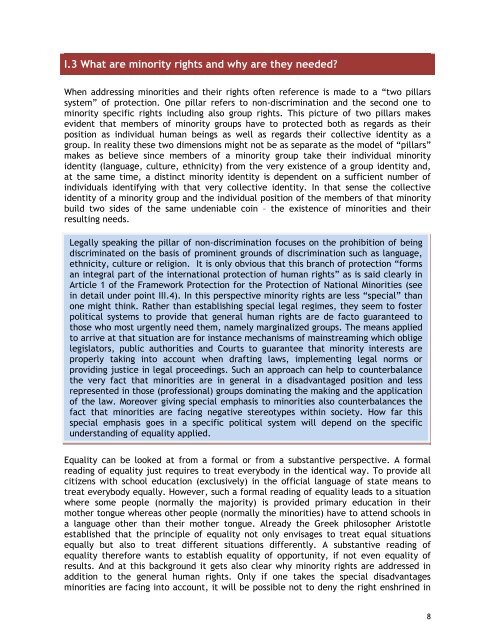Material for specialized media EURASIA-Net project - EURAC
Material for specialized media EURASIA-Net project - EURAC
Material for specialized media EURASIA-Net project - EURAC
Create successful ePaper yourself
Turn your PDF publications into a flip-book with our unique Google optimized e-Paper software.
I.3 What are minority rights and why are they needed?<br />
When addressing minorities and their rights often reference is made to a “two pillars<br />
system” of protection. One pillar refers to non-discrimination and the second one to<br />
minority specific rights including also group rights. This picture of two pillars makes<br />
evident that members of minority groups have to protected both as regards as their<br />
position as individual human beings as well as regards their collective identity as a<br />
group. In reality these two dimensions might not be as separate as the model of “pillars”<br />
makes as believe since members of a minority group take their individual minority<br />
identity (language, culture, ethnicity) from the very existence of a group identity and,<br />
at the same time, a distinct minority identity is dependent on a sufficient number of<br />
individuals identifying with that very collective identity. In that sense the collective<br />
identity of a minority group and the individual position of the members of that minority<br />
build two sides of the same undeniable coin – the existence of minorities and their<br />
resulting needs.<br />
Legally speaking the pillar of non-discrimination focuses on the prohibition of being<br />
discriminated on the basis of prominent grounds of discrimination such as language,<br />
ethnicity, culture or religion. It is only obvious that this branch of protection “<strong>for</strong>ms<br />
an integral part of the international protection of human rights” as is said clearly in<br />
Article 1 of the Framework Protection <strong>for</strong> the Protection of National Minorities (see<br />
in detail under point III.4). In this perspective minority rights are less “special” than<br />
one might think. Rather than establishing special legal regimes, they seem to foster<br />
political systems to provide that general human rights are de facto guaranteed to<br />
those who most urgently need them, namely marginalized groups. The means applied<br />
to arrive at that situation are <strong>for</strong> instance mechanisms of mainstreaming which oblige<br />
legislators, public authorities and Courts to guarantee that minority interests are<br />
properly taking into account when drafting laws, implementing legal norms or<br />
providing justice in legal proceedings. Such an approach can help to counterbalance<br />
the very fact that minorities are in general in a disadvantaged position and less<br />
represented in those (professional) groups dominating the making and the application<br />
of the law. Moreover giving special emphasis to minorities also counterbalances the<br />
fact that minorities are facing negative stereotypes within society. How far this<br />
special emphasis goes in a specific political system will depend on the specific<br />
understanding of equality applied.<br />
Equality can be looked at from a <strong>for</strong>mal or from a substantive perspective. A <strong>for</strong>mal<br />
reading of equality just requires to treat everybody in the identical way. To provide all<br />
citizens with school education (exclusively) in the official language of state means to<br />
treat everybody equally. However, such a <strong>for</strong>mal reading of equality leads to a situation<br />
where some people (normally the majority) is provided primary education in their<br />
mother tongue whereas other people (normally the minorities) have to attend schools in<br />
a language other than their mother tongue. Already the Greek philosopher Aristotle<br />
established that the principle of equality not only envisages to treat equal situations<br />
equally but also to treat different situations differently. A substantive reading of<br />
equality there<strong>for</strong>e wants to establish equality of opportunity, if not even equality of<br />
results. And at this background it gets also clear why minority rights are addressed in<br />
addition to the general human rights. Only if one takes the special disadvantages<br />
minorities are facing into account, it will be possible not to deny the right enshrined in<br />
8

















